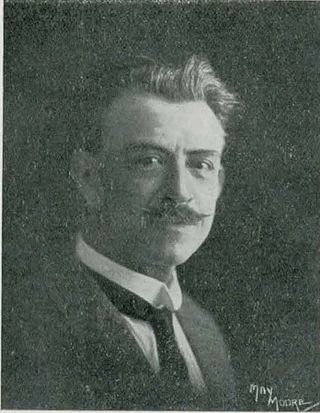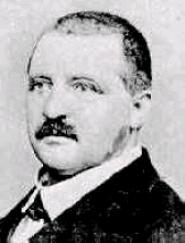Related Research Articles
Robert Wilfred Levick Simpson was an English composer, as well as a long-serving BBC producer and broadcaster.
Dmitri Shostakovich's String Quartet No. 8 in C minor, Op. 110, was written in three days.
Cyclic form is a technique of musical construction, involving multiple sections or movements, in which a theme, melody, or thematic material occurs in more than one movement as a unifying device. Sometimes a theme may occur at the beginning and end ; other times a theme occurs in a different guise in every part.

Franz Schubert's Symphony No. 8 in B minor, D. 759, commonly known as the Unfinished Symphony, is a musical composition that Schubert started in 1822 but left with only two movements—though he lived for another six years. A scherzo, nearly completed in piano score but with only two pages orchestrated, also survives.

Alfred Francis Hill CMG OBE was an Australian-New Zealand composer, conductor and teacher.

Anton Bruckner's Symphony No. 8 in C minor, WAB 108, is the last symphony the composer completed. It exists in two major versions of 1887 and 1890. It was premiered under conductor Hans Richter in 1892 at the Musikverein, Vienna. It is dedicated to the Emperor Franz Joseph I of Austria.

Anton Bruckner's String Quintet in F major, WAB 112 was composed in 1878/79 in Vienna.
The String Quartet in D major is the only string quartet composed by César Franck. The work was written from 1889 to 1890.

The String Quartets, Op. 50, were composed by Joseph Haydn in 1787. The set of six quartets was dedicated to King Frederick William II of Prussia. For this reason the set is commonly known as the Prussian Quartets. Haydn sold the set to the Viennese firm Artaria and, without Artaria's knowledge, to the English publisher William Forster. Forster published it as Haydn's Opus 44. Haydn's autograph manuscripts for Nos. 3 to 6 of the set were discovered in Melbourne, Australia, in 1982.
String Quartet No. 1 in B-flat major "Maori Quartet", Stiles 1.2.3.3 SQ1 is the first of Alfred Hill's seventeen string quartets. Its composition began before 1892, it was completed after 1896 and premiered only on 18 May 1911 in Sydney.
Alfred Hill composed his String Quartet No. 3 in A minor "The Carnival", Stiles 1.2.3.3 SQ3, in 1912, while he was a member of the Austral String Quartet. The manuscript score is preserved in the National Library of Australia. In 1955, Hill transformed the quartet into his Symphony No. 5. The quartet is composed in four movements with an average duration of 20 minutes.
String Quartet No. 2 in G minor "A Maori Legend in Four Scenes", Stiles 1.2.3.3 SQ2, often called "Maori Quartet", was composed by Alfred Hill in 1907–1911 and premiered immediately in 1911. It is dedicated to Earnest [sic] Wunderlich — "in slight appreciation". The first two quartets were published together by Breitkopf & Härtel in 1913. Each of them used to be referred as Maori, a feature that can lead to confusion. Today the first one is called Maori, while for the second the longer subtitle is retained.
Symphony No. 1 in B-flat major, Stiles 1.3.4.1 Sy1, the so-called Maori Symphony, is the first symphony by Alfred Hill. Its first three movements were completed by 1898, but the last movement remained unfinished. This may have been the second symphony composed in the Antipodes. The first two movements of this symphony are the only symphonic movements by Hill not to be arranged from his earlier chamber music. The Finale was reconstructed by Allan Stiles, and the whole symphony got its first performance in 2007. The approximate duration is 40 minutes.
Violin Sonata No. 4 in C minor "Maori Sonata", Stiles 1.2.1.6 So4, is a sonata for violin and piano by Alfred Hill composed ca.1909. It was premiered on 6 April 1910 by Cyril Monk and Laurence Godfrey Smith in the YMCA Hall, Sydney. Its approximate duration is 18 minutes.
String Quartet No. 4 in C minor, Stiles 1.2.3.3 SQ4, was completed by Alfred Hill on 25 July 1916 in Neutral Bay, Sydney. It is dedicated to Henri Verbrugghen and his Verbrugghen String Quartet. It is Hill's first non-program string quartet. The first two movements were transcribed for orchestra in 1955 forming the basis of the Symphony No. 4 "The Pursuit of Happiness" in which this music turns to have a program.
String Quartet No. 5 in E-flat major "The Allies", Stiles 1.2.3.3 SQ5, was completed by Alfred Hill on 24 June 1920 in Sydney. It is dedicated to Henri Verbrugghen, whose quartet gave the first public performance of the composition on 2 March 1921. The music of the quartet presents four nations who were allies during World War I. It was subsequently arranged by Hill for string orchestra as his Symphony No. 11 "The Four Nations". The approximate duration of the quartet is 29–33 minutes, which makes it one of the most substantial quartets composed by Hill.
Symphony No. 11 in E-flat major "The Four Nations" for string orchestra, Stiles 1.3.3.1 SyFN, was arranged by Australian composer Alfred Hill from his String Quartet No. 5 "The Allies" at some point in 1950s, but the precise date remains unknown, and there is no information about the first performance. The music of the symphony follows that of the original String Quartet, except for the Finale being 4 bars shorter than in the quartet, due to a minor truncation of the melody of the main subject at each repeat of it. The most obvious difference is the addition of the double bass part. Hill also altered the title of the composition.
String Quartet No. 6 in G major "The Kids", Stiles 1.2.3.3 SQ6, by Alfred Hill bears dedication: "for the young fry at the New South Wales State Conservatorium of Music". It was most likely written for the student string quartet groups at the Conservatorium mentored by the composer. The manuscript is dated 3 September 1927. Its technical demands being limited, it is an accessible for amateurs composition. The quartet is set in earlier style, reminiscent of Haydn, Schubert, and other classical composers. With approximate duration of only 15–16 minutes, this is the shortest of all Hill's quartets.
String Quartet No. 7 in A major, Stiles 1.2.3.3 SQ7, by Australian composer Alfred Hill was commenced in Melbourne and finished in Sydney on 18 November 1934, as stated in the manuscript score preserved in the National Library of Australia. It is thought to be the last of Hill's middle period quartets, with some impressionistic features being transitional to his later compositions. Approximate duration is 20,5 minutes.
String Quartet No. 8 in A major, Stiles 1.2.3.3 SQ8, by Australian composer Alfred Hill was finished half month after his Seventh: the manuscript score and parts, which are preserved in the National Library of Australia, are dated 6 December 1934. While the previous quartet was a somewhat transitive composition from his middle period, with the Eighths one starts counting Hill's late quartets. It is thematically unified and has many impressionistic features. In 1950s Hill arranged it into a string symphony, the first known performance of which was on 27 March 1957. The approximate duration of the quartet is 25–28 minutes.
References
- ↑ Note: Allan Stiles recommends not to use numbers for symphonies except for the first one.
- 1 2 Allan Stiles. A Catalogue of the Music of Alfred Hill
- 1 2 3 4 5 Rhoderick McNeill (23 March 2016). The Australian Symphony from Federation to 1960. Routledge. pp. 93–95, 99–104. ISBN 978-1-317-04087-3.
- 1 2 3 4 Keith Anderson. Booklet notes to Naxos 8.220345
- 1 2 3 Catalogue entry for the manuscript of the symphony